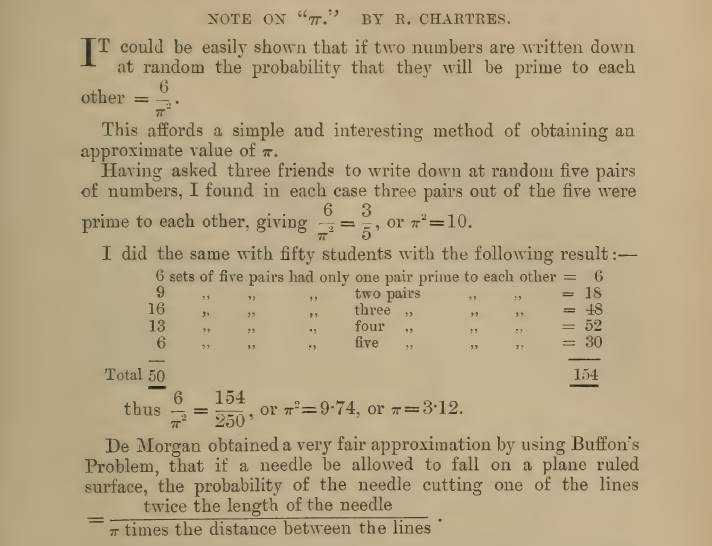In 1904, R. Chartres publishes in The London, Edinburgh and Dublin philosophical magazine and journal of science an article entitled Note on “π”1. In this short note, he states that two integer numbers chosen randomely have a probability to be prime to each other equal to 6/π2.
Reminders
Let us remind the reader that:
- prime numbers are integer numbers which can be divided only by 1 and themselves. For example, 5 is a prime number but 6 is not, as it can be written as 2 x 3.
- any integer number can be written as the product of prime numbers.
- two integer numbers are relatively prime (also called coprime or mutually prime) if they don’t share any factor other than 1 when writing them as the product of prime numbers2.
Chartres’ experiment
R. Chartres, about whom I was not able to find any additional information, describes the expriment he conducted to check this value. He asked 50 students to write each 5 pairs of numbers taken randomely. Among the 250 pairs, 154 where pairs of mutullay prime numbers, leading to an estimate of π equal to π ~ 3.12.
Try Chartres’ experiment
Assuming that the random numbers generated by your browser are really random, we designed the following tool to simulate Chartres’ experiment.
Run the experiment by choosing a number of random pairs to generate. By generating additional pairs, you can get a feeling on how slowly this method converges to the value of π.
Total Pairs Tested
0
Coprime Pairs Found
0
Coprime Ratio
-
Approximated Pi
-
Actual π ≈ 3.14159265359
Error
-
Recent Pairs Sample (last 10)
Demonstration of the relatively prime numbers probability value
The demonstration can be found in an article entitled Pi, Primes, and Probability published in IEEE Communications Magazine, March 1986-Vol. 24, No. 3 by S. Pasupathy3.
References
- A scanned version is available here: https://archive.org/details/londonedinburgh671904lond ↩︎
- https://en.wikipedia.org/wiki/Coprime_integers ↩︎
- https://ieeexplore.ieee.org/ielx5/35/23852/01093030.pdf ↩︎


Be First to Comment